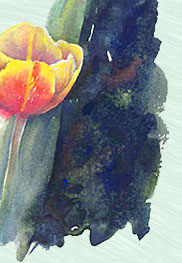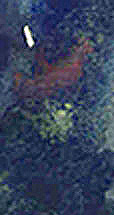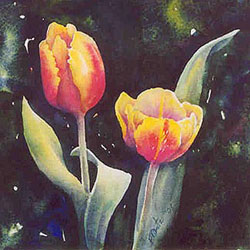|
|
|
| Welcome to Arcadia: Demos/Belcanto Tulip, page 4 |

|
Belcanto Tulip, page 4 |
|
Home About Classes Galleries Exhibits Demos What? Links Site Map
|
|
|
Now we come to the really scary part -- the background! I usually take a break after I finish the steps on page three, because it takes a little nerve to do the final stage. A little hot tea at this point does wonders (English Breakfast, yum yum).
I begin by stirring up a large batch of sap green, loosely mixed with a lot of ultramarine. I use plenty of water, so the paint will spread easily, and plenty of pigment, so it will be dark. I also prepare batches of pure sap, pure ultramarine, and a few of the other colors which have already appeared in the painting; in this case, my reds and yellows. |
||
 Adding the background |
Up until now I've been working with an assortment of round brushes, but now I switch to my favorite brush, a synthetic/natural half-inch flat. It's wonderfully responsive and holds tons of color. Alas, it's no longer being manufactured; I don't know what I will do when it finally gives out! I put some random dabs of clean water throughout the background area, occasionally brushing it up against the tulips. Then I scoop up as much of the sap/ultramarine mix as the brush will hold, and using the side of the brush, begin applying the color to the paper. I work fast and use as few brush strokes as possible, taking care not to spread the paint too far. When I see the color begin to thin, I reload the brush. Because I'm painting so fast, I leave a few "chips" of white lying around. Some of these I will paint over, but most I will leave as they are, since they create an effect of light bouncing around in the painting. | ||
|
I keep working quickly (so I can finish before the paint dries), sometimes switching to a small round brush when I need to get into a tight space. Some interesting things begin to happen. Every time my brush touches the clear water spots, the water grabs the color and moves it around, creating variations in the density of the paint. Also, the ultramarine, being a sedimentary pigment, separates somewhat from the sap green and creates interesting texture areas. I help this effect along by occasionally adding scoops of pure blue or green from the palette. Finally, I flick in a few splashes of the reds and yellows, and let them bleed out into the surrounding color. |
 | |
|
While the background color is still wet, I pull some of it onto the leaves and flowers to help blend the shadow areas with the background, and to soften some of the edges. Once the painting is dry, I'll go back into it with a sharp craft knife and scrape out any whites that might have gotten lost during the painting process. | ||
 The finished painting:
The finished painting:Belcanto, watercolor, 11"x11" |
I'll check the painting over again carefully and make any adjustments I need to the shadows, colors, shapes, etc. When I'm satisfied, I sign it and date it, cuz -- |